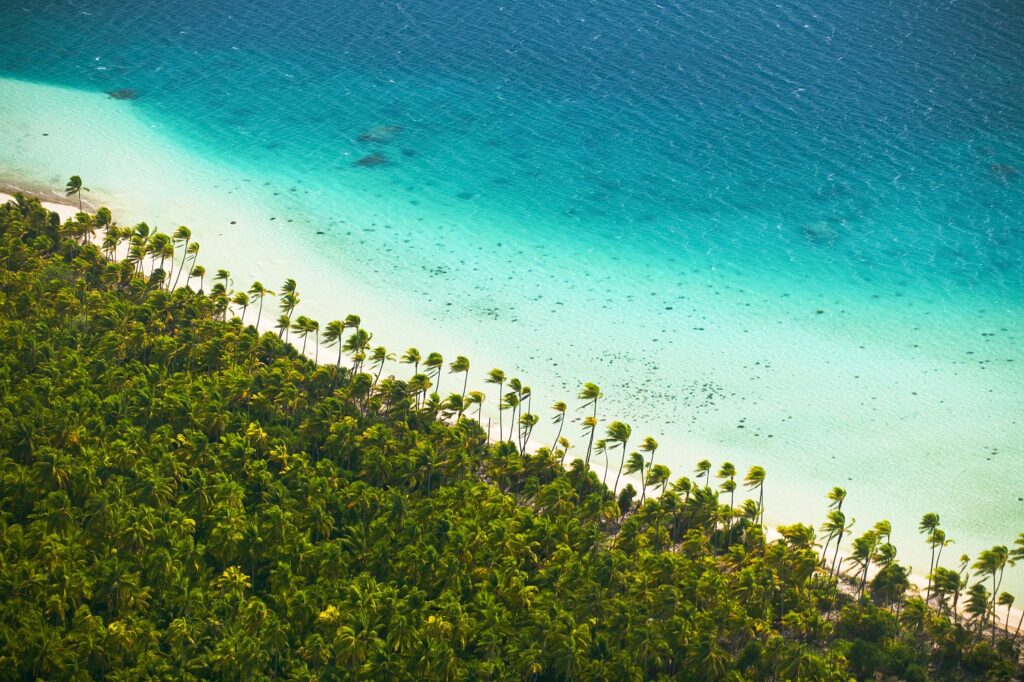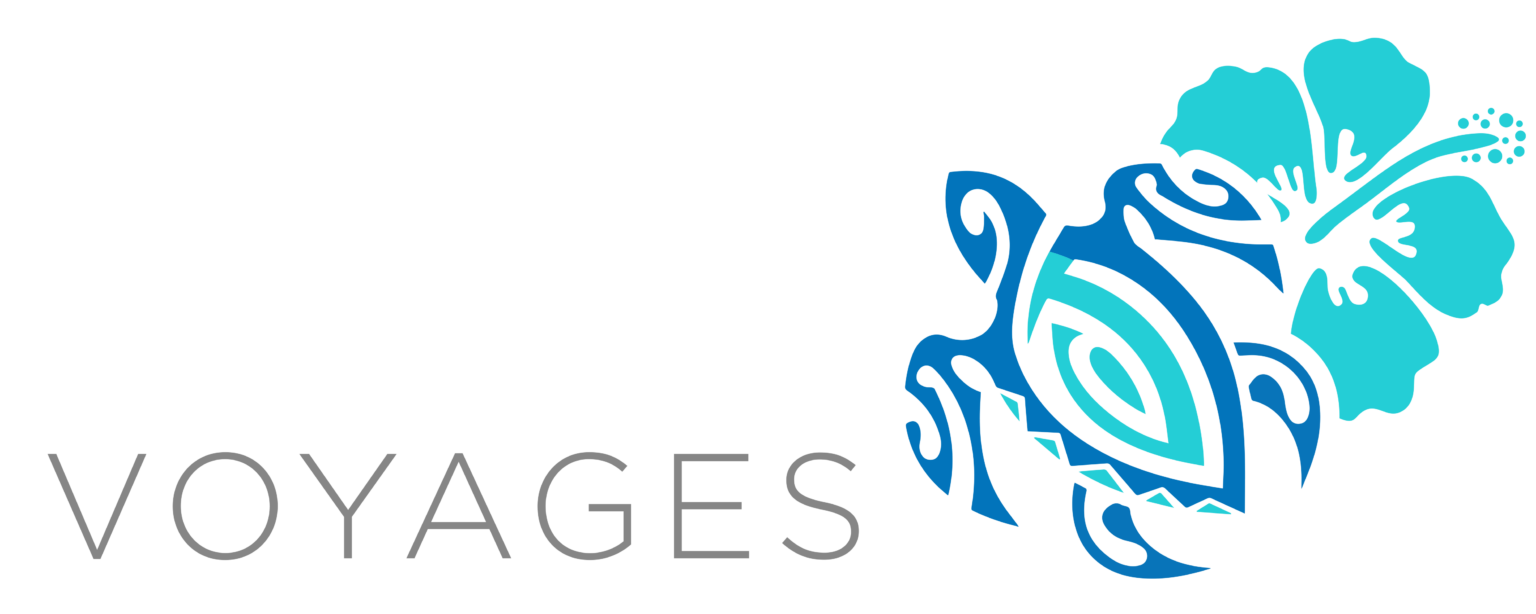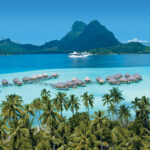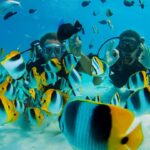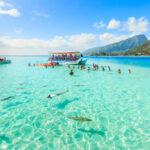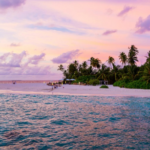LOCATION AND CHARACTERISTICS
At the heart of the Oceanian world
French Polynesia is located at the heart of the South Pacific, between 134° and 157° longitude west and between 8° and 28° latitude south, on either side of the line of the Tropic of Capricorn, in the southern hemisphere.
Made up of five archipelagos, it belongs to the eastern group of Polynesian islands. It lies to the east of Micronesia and Melanesia, other island groups which, together with Papua New Guinea, Australia and New Zealand, make up the “continent” of Oceania.
From a cultural point of view, French Polynesia is at the centre of what is commonly called the
“Polynesian triangle”. The points of this triangle are represented by the islands of Vaihī or Hawaii (to the north,) Teaotearoa or New Zealand (to the south-west) and Rapa Nui or Easter Island (to the east).
Miles away from the other continents
All of French Polynesia is located thousands of miles from the adjacent continents: Australia is 6,600 km west of Tahiti, Chile is 8,000 km to the east. To the north-east, the coast of California is 6,400 km away and the distance to Japan is 9,500 km.
Seeming light years away from Europe, the island of Tahiti is 17,000 km from Paris. This great distance from any continental land mass – although with modern aviation this is only relative – has enabled it to preserve its particular characteristics, both in the environmental and cultural field, very successfully.
“Numerous islands”
French Polynesia comprises 118 islands grouped in five archipelagos: the Society, Tuamoto, Marquesas, Gambier and Austral Islands. This multiplicity of islands is the origin of the country’s name derived from the Greek Poly, meaning many/several and Nesis, meaning islands.
Uniquely in the world, these islands are spread over an area of ocean of 5 million square kilometres. This corresponds to a surface area almost as large as the whole continent of Europe and nearly ten times that of mainland France (550,000 km2). With its 5 million km2, French Polynesia has the largest exclusive economic zone (or EEZ) of the South Pacific.
And widely spread
To get an idea, you just need to overlay the map of French Polynesia onto that of Europe.
If you position the island of Tahiti over the city of Paris, the most northerly archipelago – the Marquesas – ends up in Sweden.
To the south-east, the Gambier Islands would lie over Bulgaria. To the south, the island of Rapa, in the Austral archipelago, would be in the region of Sardinia.
As for Maupiti, situated in the Leeward Islands of the Society archipelago, it would find itself on the coasts of Brittany in France.
Rare land
The total surface area of the islands is 3,521 km2. The island of Tahiti is the largest with a surface area of 1,024 km2, meaning that it alone has more than a quarter of the total surface area of the country.
The total surface area of French Polynesia would cover barely half the surface of an island such as Corsica.
Snapshot
Flight times within French Polynesia:
- Island of Tahiti/Archipelago of the Marquesas: approximately 3 hours 30 minutes
- Islands of Tahiti/Archipelago of the Gambier Islands: approximately 3 hours 50 minutes
- Islands of Tahiti/Archipelago of the Austral Islands: approximately 1 hour 30 minutes
- Islands of Tahiti/Archipelago of the Tuamotu: 45 minutes
Geological formation and landscape
Volcanic islands
All the islands of French Polynesian are volcanic in origin. They are the summits of ancient volcanoes emerging from the ocean with the base of the volcano resting on the sea bed at a depth of some three to four thousand metres. The formation of these islands goes back to relatively “recent” times in geological terms, as they are less than 50 million years old. Created by intense volcanic activity, the Polynesian islands have no volcanoes today. Only the landscape reveals their origin.
The result of tectonic movement
On either side of gigantic undersea faults, magma from the depths of the planet feeds into tectonic plates which move slowly on both sides of these faults known as “dorsal”.
Originating in the Pacific dorsal, the Cocos and Nazca plates are advancing towards the Americas while the Pacific plate, the biggest in the world, is moving towards the west and north-west in the direction of Asia. It is this plate, advancing at a rate of around 10 cm per year, which is at the base of the islands of French Polynesia.
Summits of giant volcanoes emerged from the sea
Volcanic eruptions, known as “ripples” occurred along the dorsal causing huge volcanoes to appear which were at first under the sea then emerged from it. This is how the islands making up the Tuamotu archipelago appeared, millions of years ago. The four other archipelagos of French Polynesia (Society, Gambier, Marquesas and Austral) are the result of “hot spots”, sources of magma far distant from the edge of the plates. From these powerful springs magma spurted and formed a volcano. However, the ocean floor continued to move, although the “hot spot” did not, so that after some time the volcano which had been created was no longer fed and its activity gradually ceased. The “hot spot”, however, continued to exist, causing new volcanoes and therefore new islands in other places over the ocean plate.
This phenomenon can be seen clearly in the Society archipelago. So Maupiti, the most western island of the archipelago, is the oldest. It was formed 4 million years ago. There is nothing left of the Bora Bora volcano other than the central peak, whereas in younger islands such as Tahiti or Mo’orea, 300 km to the east, you can still see many peaks and traces of the original calderas. The island of Tahiti in fact appeared more recently, between 2 million and 500,000 thousand years ago.
Another phenomenon – known as subsidence – explains the gradual transformation of these once high islands into atolls. Once the volcano is extinct, it sinks into the ocean floor at a rate of 1 cm per year. In addition, the different layers of which it is comprised compress together. Finally, in the part above the ocean surface, erosion from wind, rain and river action contributes to the gradual but inevitable degradation of these imposing basalt structures.
The coral builders
At the same time as these volcanic phenomena, large beds of coral developed on the rocky sides of the island, leading to the construction of two types of reefs: a reef “fringing” the length of the coasts and a “barrier” reef out at sea. As the island “settled” an increasingly large lagoon was formed.
In the case of the atolls, the volcano has completely disappeared beneath the surface of the water, leaving no trace other than this ring of coral.
The reef is interspersed, in an irregular way, with motu, a name of Polynesian origin designating little coral islands. These motu are alternately submerged and revealed with the rhythm of the tides.
The reef is also dotted with shallow gashes called hōā and deeper passes or ava, which allow the waters of the ocean and those of the lagoon to mix. Most atolls have one or several passes, others, more rare, are completely closed.
The world of Polynesian atolls
The living geological formations of atolls have given rise to specific types of landscape dominated by ever-present beaches of white sand. Seen from above, the lagoons offer a magnificent palette with every shade of blue you can imagine, from indigo to turquoise. The coral bases under the sea, of remarkable biological richness and great beauty, have made the Polynesian atolls particularly renowned as sites for scuba diving. With more than 84 atolls, French Polynesia has one of the greatest concentrations of coral islands in the world.
Mountainous islands
The high islands are characterised by mountainous terrain whose altitude can vary from a few hundred to more than 2,000 metres. The highest point of French Polynesia, Mount ‘Orohēna on the island of Tahiti, rises 2,241 metres above sea level. In the Marquesas Islands, Mount Temetiu at Hiva ‘Oa, the highest summit of the archipelago, is 1,276 metres high.
Deep valleys furrow the mountainsides, carved out by torrential rivers. However, only a few have any breadth, linked in some cases to the caldera – often sunken – through which the volcano released the magma.
Volcanic plateaux, often inaccessible foothills of the mountain, form a screen between the summits and a rather narrow coastal strip where most human activity, especially tourist activity, takes place, with numerous beaches, either of black sand of basalt origin or white sand of coral origin.
These high islands therefore provide contrasting landscapes of high mountains, steep-sided valleys and a coastal strip strung with beaches. They display luxuriant vegetation (sometimes including very large trees), which varies according to exactly where it is growing: by the sea or in the interior of the island, in a valley, on a plateau or on the summit.
Terrestrial flora
Young flora
As they are “only” a few million years old, the islands of French Polynesia did not experience the slow history of the appearance of life on the continents, extending over hundreds of millions of years. Being of volcanic origin, they emerged when all the major plant groups had already appeared on the planet.
Moreover, their distance from the continental land masses means that these former volcanoes, of which some were to disappear leaving only an atoll on the surface, would take thousands more years to acquire and enable the growth of any flora arriving by air, spread by the wind and birds bringing pollen and seeds. Some species also managed to arrive by their seeds being carried by the ocean currents (such as coconuts).
But very specific to its setting
Nevertheless, these apparently unfavourable characteristics, the reason for the relative scarcity of original flora, are also behind a strong tendency for endemic species to develop, evolving to cope with specific constraints.
There are therefore slightly more than 300 endemic plant species, unfortunately nowadays often limited to isolated ecological niches (bottoms of valleys, inaccessible summits), including the famous tiare ‘apetahi, which only flowers on the slopes of Temēhani, the main summit of the island of Ra’iātea (Leeward Islands).
One thousand indigenous plant species have been recorded, including 570 flowering plants, the produce of the natural migration of species originating in the western Pacific.
In Polynesia, like everywhere else, conditions of altitude and humidity obviously affect the natural occurrence of any particular species or variety. The cloudy summits of the high islands therefore have tree ferns growing, several metres high, which are not found elsewhere. In the valleys, large tropical chestnuts or māpē (Inocarpus fagifer) are supported by spectacular and curiously resonant exposed roots.
The vegetation of the atolls, with their salty coral soil and very little humus – clearly very different from that of the high islands – has managed to adapt to these difficult conditions, even though it is exposed to constant sea spray and strong sunlight.
Numerous plants introduced by Man
Numerous plants have been introduced by Man over the centuries, some after “domestication” by humans of the Paleolithic age, ancestors of the Polynesian migrant sailors who first occupied the Pacific islands. So one finds that a certain number of useful plants have been present for more than a thousand years, such as bananas, coconut palms and the tumu ‘uru or breadfruit tree, the reason for the expedition of the Bounty in 1787.
Among these are also found tubers such as the taro and the yam, as well as the South American sweet potato which was no doubt brought back from expeditions which reached as far as that continent.
European sailors, in their turn, introduced others, from the middle of the eighteenth century onwards and in several successive waves. There are today more than 1,800 species, including many fruit – some of which has done particularly well in the regional edaphic (soil + climate) conditions. That is the case with the grapefruit and pineapple, for example, whose quality and taste are universally recognised. Nor should we forget vanilla, fruit of the orchid Vanilla tahitensis, with a flavour unique in the world.
The enriching of Polynesian flora by Man was not always done with great thought and has sometimes proved harmful to the conservation of harmonious biodiversity. Thus we see that a certain number of invasive species have been introduced, “plant pests” like the “miconia” (Miconia calvacens), which dominates all other species to their detriment, accelerating the process of the destruction of endemic or indigenous plants which are poorly equipped genetically to resist these invaders. This now justifies very strict controls on all plant imports.
Land and marine fauna
Original land fauna
The same geological conditions which gave rise to relatively sparse original land flora – in terms of the number of species present before any were introduced by Man – were also the reason for even less diversity as far as the animal kingdom is concerned, at least on land.
Before the arrival of the earliest Polynesian sailors, there were only a few species of insects, in particular spiders which had been able to travel by allowing themselves to be carried on air currents. While one cannot fail to notice nowadays the presence of mosquitoes and other flying insects that bite, including the famous nono, one must also note that there are several species of dragonfly, numerous nocturnal and some diurnal butterflies. Arriving as stowaways in the Polynesians’ dugout canoes, with the earliest waves of migration, brown rats rapidly colonised high islands and atolls. The pig, dog and hen, on the other hand, had their place reserved aboard these great craft, with Man and the Gods.
As for the other mammals which can be found nowadays – cats, goats, then cattle and horses – their ancestors came from the hold of the ships of the “circumnavigators”, from the middle of the eighteenth century, along with black rat stowaways.
The horses in the Marquesas Islands are now half wild and contribute to the tourist image of this archipelago, as do the herds of dairy cows grazing the pastures of the Taravao plateau, on the Tahiti Iti Peninsula.
Freshwater crustaceans such as the shrimp known locally as “chevrette” – whose larva develops in the sea – live in the current of the torrential rivers of the high islands while another species – originally from Malaysia – is farmed in tanks. Half-terrestrial half-aquatic crabs called tupa, a type of hermit crab, u’a or ‘aveu according to their size, live in burrows by the sea but are also capable of climbing the coconut palms and crushing the shell and insides of the coconut to eat the flesh.
Birds unique in the world
Birds are represented by just over a hundred species, with more sea birds than land species. Here too, scarcity is compensated for by the fact that most of the birds in French Polynesia cannot be found anywhere else in the world and are strongly endemic to the area. Unfortunately, some species have disappeared, such as the Tahitian red-billed rail or the Tahiti parakeet described by naturalists on Captain Cook’s expeditions. Others, like the Tahitian monarch flycatcher, now only have a few remaining examples in certain isolated valleys and have been classified as critically endangered by Bird Life International. There are still green herons and laughing kookaburras but their habitat is threatened by the degradation of the coastline. Among the sea birds, migratory birds and endemic species exist alongside one another, with certain islands like Teti’aroa (a private atoll belonging to the descendants of the actor Marlon Brando) being home to large colonies.
Wealth of the coral reefs
The high islands, especially those of the Society archipelago, enjoy both a fringing reef and island influences (briny lakes, mangroves, etc.) which allow numerous species of marine flora and fauna to reproduce. Algae, the first link in the food chain as they provide food for countless species of fish, are also essential for making coral in water whose temperature (between 20° and 30°C) and luminosity encourage it to grow to heights of dozens of metres, thus helping to build a barrier reef of several dozen kilometres.
This barrier reef and the lagoons host a whole range of sea urchins, sea cucumbers and crustaceans (spiny lobsters, slipper lobsters, crabs) and starfish.
You can also find many shellfish of very varied types (limpets, nerite snails, turbo snails, troca shells, winkles, etc.) and oysters cultivated for their shells or pearls since pearl farms were established several decades ago, mainly in the Tuamotu atolls. It should be noted that collecting shells is subject to legislation in French Polynesia and certain species are protected. The fish in the coral islands are renowned for the diversity of their shapes and colours, making it very difficult to compile an exhaustive inventory. The water of the lagoons is so clear that watching them is a fascinating activity.
Numerous marine mammals
Beyond the reef stretches the domain of the deep sea fish (tuna, skipjack), fish of the depths
(mahimahi or dorade coryphène) but also several types of swordfish and large sharks or rays, several species of which can be found in the shallow waters of the lagoon or around the reef.
There are no land tortoises but there are sea turtles which used to be caught throughout the archipelagos and especially in the Tuamotu. Today there are three species: the green sea turtle, which is in danger of extinction, the hawksbill sea turtle and the huge leatherback sea turtle, which is the rarest.
Finally, of all the marine mammals, the cetaceans were invested with great symbolic power by the ancient Polynesians. Near the coasts can be seen several species of porpoise and dolphin – the most common being the spinner dolphin which is not afraid of entering the lagoons. One often comes across whales of several species travelling through Polynesian waters during their ocean migration in search of food and in their reproductive period. They are mainly seen between July and October, especially in the Austral Islands where the humpback whales provide a show for tourists. The territorial waters are now designated as protected areas for whales and it is strictly forbidden to hunt them.

